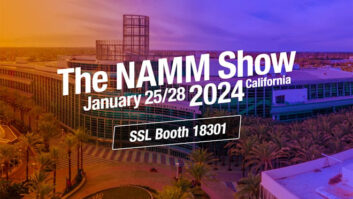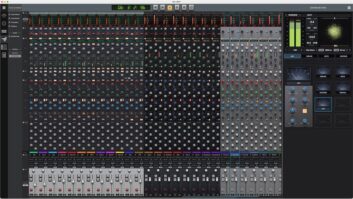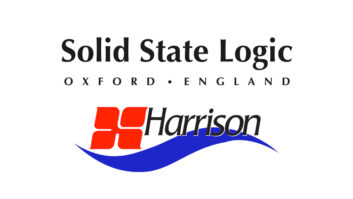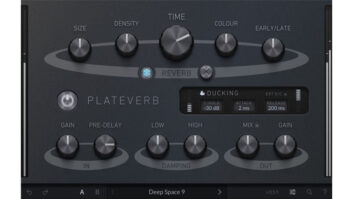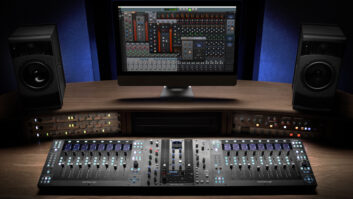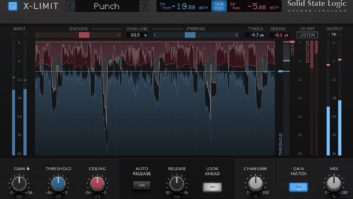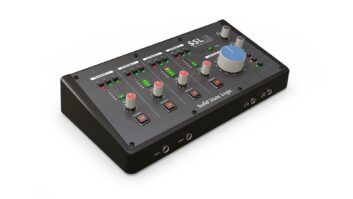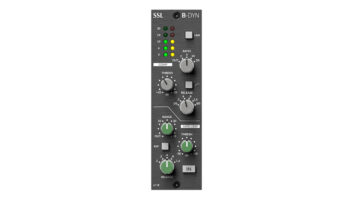It’s now old news that Solid State Logic (SSL), long known for large-format consoles housed in studios worldwide and their influence on the sound of recorded music, finally allows audio professionals at nearly every income level the opportunity to own its gear.
For the X-Rack Series, SSL broke out individual components of its revered consoles, such as the XLogic G Series compressor and Alpha VHD Pre, allowing a scalable studio infrastructure that vastly broadened its user base.
In our view, the X-Desk, SSL’s most compact desktop (and rackmountable) studio hub/summing mixer, is the ultimate project-studio summing mixer. Then X-Patch — a 16×16 routing matrix that allows complex, user-defined routing chains for outboard processing gear, effectively creates an outboard/plug-in hybrid with tantalizing possibilities in studio and stage environments. So, old news or not, X-Desk combined with the routing capabilities of the X-Patch finally warrants a full PAR review, as the assemblage of equipment it encompasses is something we (and possibly many within PAR’s readership) have longed for.
Recently, Tim and I had the opportunity to install and test an X-Desk/X-Patch combo at Tim’s home studio in New York City.
Features: X-Desk
X-Desk and X-Patch feature SSL’s SuperAnalogue design and electronics, characterized by a wide frequency range, full bandwidth and very low distortion. In that respect alone, X-Desk is exciting right out of the box. At first glance, it appears to be a straightforward 8-channel analog console with cue and effects sends, but that simple appearance is deceptive.
X-Desk’s channel strips feature two line inputs, the second selected via an ALT switch; a +/-20 dB indented Input Level Trim; Insert switch; Phase Reverse button; and three-color LED signal indicator. Next is a Channel Output Routing button, which toggles between pre- and post-fader channel output signal, followed by the Stereo CUE send level and pan control; post-fader button for same; and a button to assign the ALT input to CUE. Each channel has two mono effects sends, switchable between pre- and post-fader, with pan control. Finally, there are mute and solo buttons and a 100 mm analog fader.
To the right of the X-Desk’s eight channels is a stereo meter, and to its right are CUE and FX Bus masters consisting of Master Send Level for CUE Bus with After Fade Listen, FX Bus 1 and 2 master controls with level and AFL, and PRE switch to change FX sends to pre-fader.
Directly beneath that is the MIX Bus master section, featuring CUE to MIX switch, MIX bus level control, MIX bus Insert In/Out button and Insert Sum switch, which sums the Insert Return with the original Mix Bus feed. This is a nice feature if, for example, you wanted to send your stereo bus to a compressor and blend the compressed signal into the original. Stereo Returns 1 and 2, positioned to the right of the MIX Bus master section, feature CUE and Mix bus assignment buttons, pan control, a mono switch, level control and AFL switch.
To the right of the faders are Talkback and Monitor level control, including an internal talkback mic and its level control; dim control; and loudspeaker output level control. The Monitor Source section consists of a SUM button; iJack assignment button (yes, X-Desk sports a 3.5 mm input for iPods and the like); EXT, which assigns the Stereo Line Input from the CENTRE IN D-Sub connector to the monitor source; MIX button; ALT L/S switch (X-Desk allows for two sets of monitor speakers, Large and Small); and a MONO switch. Below are DIM, CUT and Talkback switches and, last but not least, quarter-inch headphone out, aforementioned iJack input, headphone level control pot and CUE to headphones button, which assigns the CUE bus to the headphone output.
On the rear panel, the X-Desk uses D-Sub connectors. Starting at the right, the first D-Sub port is for Alt Input. In our setup, the output of Pro Tools was sent to X-Desk via a Digi 002 Rack for playback. The next is for Line Input, into which we fed a Focusrite ISA 220 Session Pack mic pre. To the left are two D-Sub ports for each channel’s Insert Send and Return. These we connected to the first eight ins and outs of the X-Patch, which also features D-Subs. Next is Direct Out (Channel Output, or CH OP), which we fed back into the DAW. Then come the Link In and Link Out ports, used if cascading multiple X-Desks (up to eight can be cascaded for a staggering 160 analog inputs on mixdown) and an X-Rack Expansion D-Sub to integrate an X-Rack. The final two D-Sub ports are for Center In (Insert Return, External Stereo In, Stereo Returns 1 and 2) and Center Out (MIX Bus output; CUE Bus output; FX 1 and 2 Bus Outputs; and master MIX insert send). To the left are two pairs of XLR outputs for the main and alternate speakers.
The X-Desk fills a void in the market by providing 16 channels of summing with fader control, inserts for analog gear, and effects sends. Yes, you have the option of using X-Desk as a standard inline monitoring console. But with 16 inputs in a mixing scenario, this becomes the perfect summing amp, exactly what many of us have sought since the dawn of the DAW era. X-Desk provides eight channels with faders and, because the Cue Sends also become inputs in mixdown, eight more channels with small pots. You also have effects sends and the Insert button, where an outboard compressor or EQ, for example, can be added.
In a summing-bus scenario, channels 1 through 8 could have faders, while 9 through 16 would be Cue Sends with the faders dedicated to more delicate balancing. Cascading two XDesks would provide 32 channels of mix with 16 faders; for hybrid in-the-box mixing, it’s difficult to imagine needing more. It’s clear that the addition of an SSL X-Rack packed with mic pres, compressors and EQ would essentially create a small SSL console. Regardless, this “home-sized” SSL desk is a very cool inline-monitoring-console-meets-perfect-summing-mixer. In X-Desk, you have inserts, sends, and talkback: just like a real console and just what we wanted.
After using the X-Desk as a summing device, we were very impressed with sound of the mixes. It has plenty of headroom and, thanks to SuperAnalogue circuitry, the mix was open and dimensional.
X-Desk is so well thought out, in fact, that one omission stands out as an odd quirk, but it’s our only complaint; the ability to send discrete mixes to headphones and control room speakers, for example, would be useful. [According to SSL, “It is possible for the Headphone Output to source the CUE Bus. An independent mix could be built up via the channels Cue sends and then, by engaging the CUE to H/P switch, you can have a different mix through your headphones than that coming out of your loudspeakers.” — Ed.]
Features: X-Patch
With the 1U X-Patch, you can bid farewell to patchbays, cables and the considerable time spent with them. X-Patch, with its digitally controlled SuperAnalogue signal path, is used with XPatch Remote software via Ethernet connection to a computer. With X-Patch Remote, individualized chains of outboard gear as well as insert send and returns are easily routed, stored and recalled. One X-Patch can store 128 routing presets, all of which can include any of 128 user-configured chains. Up to six X-Patches can be cascaded and controlled from one Remote.
The front panel of X-Patch features a pair each of XLR/quarter-inch inputs and outputs as well as the power switch. A musician, for example, can use these front inputs and outputs plugging a guitar into the front, using the routing for effects, and then come out the front panel to an amplifier. The back panel houses inputs and outputs 1-16, each comprised of a pair of D-Sub ports; Ethernet port; and MIDI In and Thru ports.
The Remote software is straightforward; defining Inputs and Outputs plus creation of Chains and Presets are quickly accomplished in the Setup window. Here, 16 rows represent the in/out pairs with Source and Destination columns to the left and right, respectively, plus Unlink, Device and Insert select buttons as well as a +4/-10 dBu level matching option. Of interest to iPhone, iPad, and iPod Touch users, a remote control application for the X-Patch can be downloaded for free from the Apple App Store.
In Use
In our X-Desk with X-Patch test drive, we started by assigning channels 1-8 to the insert sends and returns of the X-Desk. We then assigned channels 9-13 to various pieces of outboard and, using the – 10 dBu option, a couple of guitar devices on 14 and 15 (a Line 6 POD and a stompbox effect unit). Then we started recording and mixing.
We created a Pro Tools session and added left and right tracks of Toontrack EZdrummer (routed to channels 1 and 2 on X-Desk) and a grand piano from Pro Tools 8’s virtual instrument library (channel 3). An electric bass was plugged into the instrument input of the Focusrite pre, routed to the Line In of X-Desk on channel 8. By using the direct output of channel 8 we fed the signal to the DAW using fader 8 as our level. The output of fader 8 is monitored directly, so we had zero latency.
We decided to compress and EQ the bass, so we created and saved a new chain in X-Patch Remote. In seconds, we had added a Chandler TG1 compressor and a Meyer Sound CP-10 EQ, named the chain “Bass Record,” and added it on the Insert of Channel 8. Now, this typical bass-record chain can be called up with a click of the mouse.
Before adding electric guitar to our test session, we created a “Comp Guitar Record” chain, consisting of the POD into the TG1 into the CP-10. Another chain, this for a female vocalist on a different project, had the CP-10 going to a Universal Audio LA-4. Still another routed the CP-10 to a tremolo stompbox for a weird, “vibey” bass effect. With 128 storable, recallable chains and presets, XPatch offers lots of convenience.
Note that an Ethernet router would be needed to use more than one unit. The software will assign IP numbers as needed. Using one X-Patch connected directly to your computer, you will need to manually assign an IP address, which can be found in the user’s guide at the SSL website. I must say that for self-recordists and musician-type users, the onstage possibilities of X-Patch are immense. With a MIDI controller, incorporating stompbox effects and studio-quality delay units into a guitar rig for example, becomes simple, fast and extremely convenient, along with the ability to instantly route any combination in any order.
Summary
This combination of SSL “X” gear can form the basis of many a modern production facility. Just imagine a recording, voiceover or post-production environment hosting multiple engineers, each with their own gear and signal-chain preference and methodology. With a click of the mouse, a personal routing scheme, incorporating multiple outboard units and console inserts, sends and returns, is in place. At a small fraction of a large-format console’s price, this modular approach is suitable to a very broad user base.
Prices: $2,899 and $1,199 (X-Desk and X-Patch, respectively)
Contact: Solid State Logic | 212-315-1111 | solid-state-logic.com
Tim Hatfield has been a freelance producer/engineer/mixer in NYC for 20 years and is co-owner of Brooklyn’s Cowboy Technical Services. Christopher Walsh is a freelance writer, musician and engineer based in New York.
